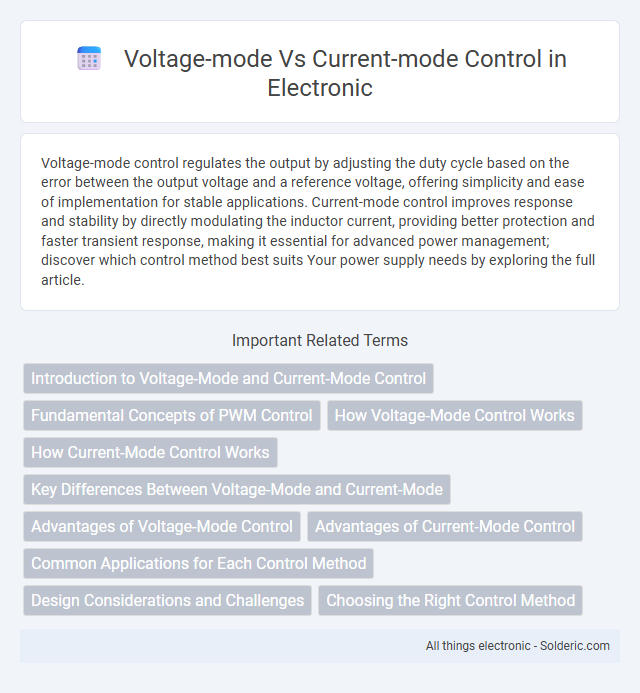Voltage-mode control regulates the output by adjusting the duty cycle based on the error between the output voltage and a reference voltage, offering simplicity and ease of implementation for stable applications. Current-mode control improves response and stability by directly modulating the inductor current, providing better protection and faster transient response, making it essential for advanced power management; discover which control method best suits Your power supply needs by exploring the full article.
Comparison Table
| Feature | Voltage-Mode Control | Current-Mode Control |
|---|---|---|
| Control Variable | Output voltage | Inductor current |
| Loop Type | Single feedback loop | Dual feedback loops (voltage and current) |
| Response Speed | Slower transient response | Faster transient response |
| Stability | Less stable, requires compensation | More stable with inherent current limit |
| Complexity | Simple design | More complex implementation |
| Current Limiting | No direct current limit | Built-in current limiting |
| Applications | Low-cost, simple power supplies | High performance, fast response converters |
Introduction to Voltage-Mode and Current-Mode Control
Voltage-mode control regulates the output voltage by adjusting the duty cycle of a power converter based on the error between the output voltage and a reference voltage. Current-mode control enhances system response by incorporating an inner current loop that directly controls the inductor current, providing inherent overcurrent protection and improved transient performance. Your choice between these control techniques impacts stability, noise sensitivity, and the complexity of the power supply design.
Fundamental Concepts of PWM Control
Voltage-mode control regulates the output voltage by adjusting the duty cycle of the PWM signal based on the error between the desired and actual voltage. Current-mode control directly modulates the inductor current by using the current error to shape the PWM duty cycle, providing faster response and inherent overcurrent protection. Your choice depends on the application requirements, with current-mode offering improved stability and simplified compensation in switching power supplies.
How Voltage-Mode Control Works
Voltage-mode control regulates the output voltage by comparing the feedback voltage to a reference voltage and adjusting the duty cycle of the switching transistor accordingly. A pulse-width modulator (PWM) generates gate signals based on this error voltage, ensuring the output remains stable despite load variations. This method relies on a single feedback loop controlling the switch timing, making it simpler but sometimes less responsive than current-mode control.
How Current-Mode Control Works
Current-mode control regulates the output by directly controlling the inductor current, using a feedback loop that compares the sensed current against a reference signal to adjust the duty cycle of the power switch. This approach provides inherent overcurrent protection and simplifies the control loop by effectively converting a power stage into a current source, improving dynamic response and stability. By modulating the peak inductor current, current-mode control enables precise regulation of output voltage in switching power supplies and DC-DC converters.
Key Differences Between Voltage-Mode and Current-Mode
Voltage-mode control regulates the output voltage by adjusting the duty cycle based on the error between the reference voltage and the output voltage, typically requiring an external compensation network for stability. Current-mode control directly controls the inductor current, providing inherent overcurrent protection and faster response to load changes by using the current error to modulate the duty cycle. Key differences include improved transient response and simpler loop compensation in current-mode control, while voltage-mode control offers better noise immunity and simpler design for certain applications.
Advantages of Voltage-Mode Control
Voltage-mode control offers simpler implementation and better noise immunity in power supply regulation, making it ideal for low-frequency applications. It provides easier loop compensation and stable operation with fewer components, which reduces system complexity and cost. This method also ensures faster transient response due to direct control of the output voltage, improving overall system reliability.
Advantages of Current-Mode Control
Current-mode control offers enhanced line regulation and faster transient response by directly regulating the inductor current, improving system stability and simplifying compensation design. It provides inherent overcurrent protection and better noise immunity compared to voltage-mode control, making it ideal for switching power supplies and DC-DC converters. This control method also reduces the effect of component variations and load changes, leading to more accurate and reliable output voltage regulation.
Common Applications for Each Control Method
Voltage-mode control is widely used in power supplies for consumer electronics, LED drivers, and battery chargers due to its simplicity and ease of implementation. Current-mode control dominates in applications requiring fast transient response and enhanced protection, such as DC-DC converters in telecommunications, automotive electronics, and high-performance computing systems. Both methods optimize power efficiency and stability depending on the specific load dynamics and system requirements.
Design Considerations and Challenges
Voltage-mode control requires precise compensation network design to maintain stability and fast transient response, often complicating the feedback loop due to sensitivity to parametric variations. Current-mode control simplifies loop compensation by effectively converting the power stage into a current source, enhancing line regulation and providing inherent overcurrent protection, but it demands careful handling of current sensing noise and slope compensation to prevent subharmonic oscillations. Designers must balance these factors, choosing between voltage-mode's simplicity in implementation and current-mode's improved dynamic performance and protection features.
Choosing the Right Control Method
Selecting between voltage-mode and current-mode control depends on your application's requirements for stability, response speed, and complexity. Voltage-mode control offers simplicity and is effective in systems with stable input voltage, while current-mode control provides improved transient response and inherent overcurrent protection, making it ideal for dynamic load conditions. Assessing your system's load variation and protection needs ensures the right control strategy optimizes performance and reliability.
voltage-mode vs current-mode control Infographic

 solderic.com
solderic.com